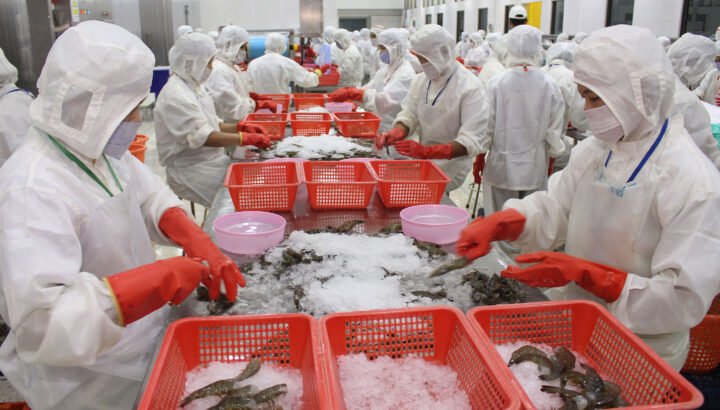The value of fisheries exported slumped by USD $ 20 million in the past two months of current 2020 – 2021 financial year
17 ธันวาคม 2563
The value of Myanmar’s fisheries exports in the past two months dropped by US$20.7 million compared with a year-ago period on account of the border trade restrictions by the neighbouring countries China and Thailand amid the COVID-19 crisis.
Myanmar exported $146.849 million worth fishery products to the external market between 1 October and 27 November of the current financial year 2020-2021. The figures plunged from $167.549 million registered in the corresponding period of last FY, the Ministry of Commerce’s data showed.
Myanmar’s fisheries export slightly declined over the past two months, owing to the pandemic-induced restrictions in the border trade. The export will undoubtedly grow if the trade route is open, said an exporter from the Muse border.
Myanmar Fisheries Federation (MFF) targets to earn over US$1 billion from fisheries exports in the current financial year started from 1 October 2020, said U Win Kyaing, general secretary of MFF.
Myanmar sends fish and fishery products to external market through air, sea and land border.
Myanmar exported 670,000 tonnes of fishery products to 45 countries in the past 2019-2020FY ended 30 September, generating an estimated income of $850 million despite the difficulties triggered by the COVID-19 crisis. The figure reflected an increase of over $120 million registered in the 2018-2019FY, MRF’s data indicated.
“We saw a remarkable increase in fishery exports last FY amid the COVID-19 impacts. MFF is endeavouring to fulfil the requirements of the market. Resources are limited for wild-caught fish exports as we look forward to long-term interest. In the farming sector, we balance between demand and supply. We will expand the market in the post-coronavirus era, and the market will undoubtedly grow. The sector also helps develop the rural community and create jobs for residents. Additionally, government coordination and guidance play a vital role in the development of the sector. As this sector also helped inject the economy of the country amid the COVID-19 impacts, we like to request the government to prioritize the sector as well,” U Win Kyaing told MRTV in the second week of October.
Myanmar exports fisheries products, such as fish, prawns, and crabs, to over 40 countries, including China, Saudi Arabia, the US, Japan, Singapore, Thailand, and countries in the European Union.
The MFF is making concerted efforts to increase fishery export earnings by developing fish farming lakes which meet international standards and adopting advanced fishing techniques.
The foreign market requires suppliers to obtain Hazard Analysis, and Critical Control Points (HACCP) and Good Aquaculture Practices (GAAP) certificates to ensure food safety.
Fishery products must be sourced only from hatcheries that are compliant with GAAP to meet international market standards. The MFF is working with fish farmers, processors, and the Fisheries Department under the Ministry of Agriculture, Livestock, and Irrigation to develop the GAAP system.
Processors can screen fishery products for food safety at ISO-accredited laboratories under the Fisheries Department.
There are 480,000 acres of fish and prawn breeding farms across the country and more than 130 cold-storage facilities in Myanmar. And 28 of them have been given the green light to export to EU countries.
Myanmar exported 340,000 tonnes of fishery products worth $530 million in the 2013-2014FY, 330,000 tonnes worth $480 million in the 2014-2015FY, 360,000 tonnes worth $500 million in the 2015-2016FY, 430,000 tonnes worth $600 million in the 2016-2017FY, 560,000 tonnes worth $700 million in the 2017-2018FY, and over 580,000 tonnes in the 2018-2019FY, the Ministry of Commerce’s data showed.
The federation has asked the government to tackle problems faced in the export of farm-raised fish and prawns through G2G pacts and ensure smooth freight movement between countries to bolster exports, according to the MFF.
Myanmar’s economy is more dependent on the agricultural sector to a large extent. Also, the fisheries sector contributes a lot to the national gross domestic product (GDP). More than 3.5 million people are relying on the industry. Its fishery production, including shrimps and saltwater and freshwater fish, is far better than the regional countries. If the government can boost processing technology, it will contribute to the country’s economy and earn more income for those stakeholders in the supply chain, Yangon Region Fisheries Department stated.
(The Global New Light of Myanmar: https://www.gnlm.com.











